Things fall inside pianos.
Objects I’ve found while tuning: pencils, paperclips, a harmonica, coins, rolled dollar bills (yeah, I know), CDs, pieces of paper, markers, dolls, legos, toy blocks, erasers, sheet music, envelopes, crayons, a hair comb, hair clips….
I could keep going, but we would be here all day. The point is that things easily fall into pianos. Ok, not all of the things listed above fall in. Some of those were definitely PUT in there by some sneaky kids, more than likely. What does fall in easily are the small things, especially pencils and pens. If you’re like me, you are teaching or playing and you always have a pencil on the piano. Then, later on, you go to look for that pencil and it is gone. Did a troll take it? A ghost? Maybe your spouse “borrowed” it? The more likely answer is that it fell in.
The problem with this is that a pencil can cause quite a bit of havoc in a piano, depending on where it lands. And quite often, it lands under the action (hammers and stuff), but above the keys toward the back. This is the spot where the key triggers the hammer to move and actually play. So, what does this mean for your piano? Simple. It means those keys won’t work. A pencil is about the length of 5 or 6 keys when it’s the long way. Now you’ve got a bunch of keys that won’t play, dang it!
Now, there are a lot of other things that can cause a key(s) not to play that have nothing to do with pencils. However, if the key won’t even push all the way down, or many keys for that matter, it’s probably something in the piano. Before you call your piano tuner over for a house call, you can pretty easily do a little investigating on your own. Lets go over how to open up your piano for a visual inspection of your piano. Please don’t mess around in there! If you see a pencil (or harmonica or whatever) go ahead and pull it out. If you don’t see anything, then you know you may need to call your tuner to come and check it out.
For uprights, first take everything off the top. I know you have pictures and stuff on top of that piano. We all do. Once it’s all off, lift the lid. Most upright lift from the front and are hinged at the back (see picture A). Some fancy shmancy uprights lift on the right side and are hinged on the left side (see picture B). A few older uprights lift all the way up from the bottom front (see picture C).
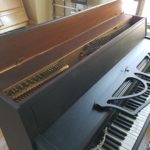
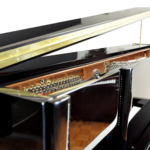
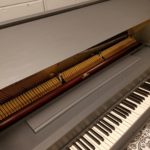
If your piano is like most, you will have lifted just the top. Next, pull the front panel off. Some just slide out, while some have little hooks on the inner sides. Just pop your head in there and look to see what you’ve got before you try to pull that panel off. Now, once you can see all the goods, do a visual inspection of the piano. Here are some pictures of where the pencil could be located within the piano. If you see it (or the harmonica), just grab it! Voila! You’re amazing!! Now, put everything back on and play some Beethoven.
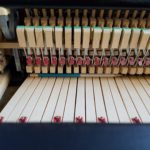
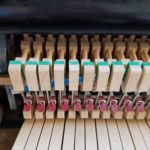
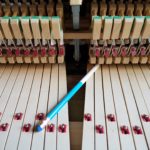

Do you have a grand? Well, this post is a little long, so next time I’ll give the rundown on taking stuff out of a grand.
I sure hope you’ll take this info and keep it in your back pocket. Thanks for reading! Oh, and hey, since you’re already here, go check out some of our music nerdy goodies in the webstore.
Musically,
Marta
Your Piano Gal
